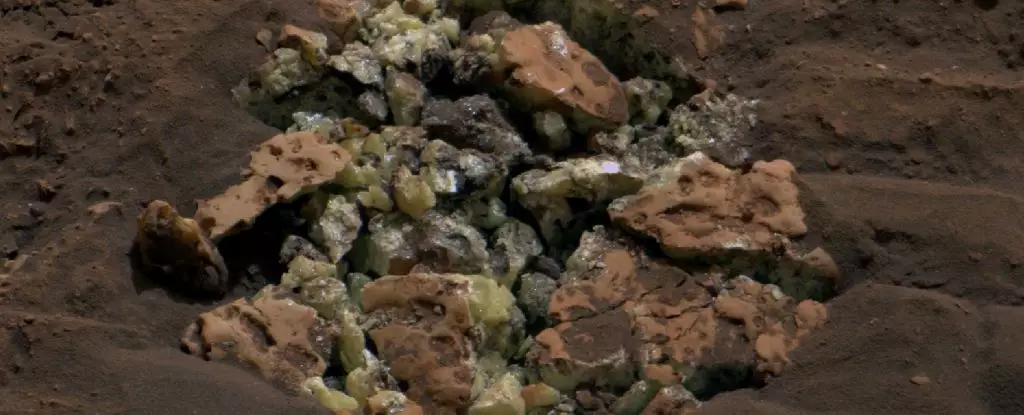The recent accidental discovery of elemental sulfur on Mars has turned planetary science on its head. When NASA’s Curiosity rover inadvertently fractured a seemingly ordinary rock in the Gediz Vallis Channel, it exposed a surprising treasure: shimmering yellow crystals of pure sulfur. This isn’t just a minor geological curiosity; it’s an unprecedented revelation that challenges long-held assumptions about Mars’s surface chemistry and its geological past. While sulfates have been a familiar signature in Mars’s mineral record, the presence of uncombined elemental sulfur signals that the planet’s geochemistry might be far more intricate and dynamic than previously presumed.
What makes this discovery especially compelling is the rarity of elemental sulfur in planetary surfaces outside Earth. Sulfur, in its pure form, requires very specific environmental conditions to form and persist. On Earth, sulfur deposits are often associated with volcanic activity or intense hydrothermal systems. The implication that such environments—either ancient or ongoing—could have existed, or still exist in some form on Mars, opens up intriguing questions about planetary geology and the potential for habitable niches. The find hints at a complex history where sulfur could have played a role in past volcanic episodes or other hydrothermal processes, mechanisms that are intimately linked with planetary evolution and astrobiological potential.
The Significance for Martian Habitability and Future Research
From an astrobiological perspective, sulfur is a cosmic key. It’s a fundamental building block for biological life, integral to amino acids and proteins. Although sulfates were known to Mars long before this discovery and are associated with evidence of ancient water, the identification of pure sulfur raises questions about what environments on Mars could support the stability of such deposits. The fact that pure sulfur appears to be concentrated in certain regions, like the Gediz Vallis Channel, which is strewn with similar-looking stones, suggests localized processes that may involve volcanic activity, mineral vaporization, or other geochemical phenomena not fully understood.
The presence of this “sulfur oasis” is an extraordinary anomaly. It’s akin to stumbling across an oasis in a desert, a rare and precious find. It compels scientists to revisit theoretical models of Mars’s environmental history, incorporating the possibility that sulfur deposits formed under conditions quite different from those recorded by sulfate minerals. Moreover, this discovery exemplifies the importance of chance in planetary exploration: had Curiosity not driven over that particular rock, this piece of planetary puzzle might have remained hidden for decades. It underscores the necessity for continuous, methodical examination of every inch of explored terrain, for in planetary science, the unexpected often holds the keys to new understanding.
Apart from the scientific implications, this finding introduces a broader narrative: Mars is more complex and enigmatic than we imagined. The planet’s geological record appears to contain surprises that challenge static models and point toward dynamic processes still submerged in the planet’s deep past, or perhaps ongoing today. Future missions, especially those equipped with advanced mineral analysis tools, will need to scrutinize these sulfur-rich regions more intensely, probing the conditions that fostered their formation and stability.
The Broader Implications for Planetary Science and Humanity’s Search for Life
This discovery shines a spotlight on the importance of planetary exploration as a means of not only understanding Mars but also gaining insights into planetary processes that could be universal. The presence of elemental sulfur, particularly in such significant quantities, suggests that planetary bodies can host diverse geochemical environments that defy simple classification. It raises questions about whether similar processes happened on Earth, or elsewhere in the cosmos, and how planetary atmospheres and interiors can give rise to pure elements on the surface.
Furthermore, the discovery invites speculation about Martian biosignatures. While no direct signs of life have been found, the organic and inorganic chemistry hints that conditions conducive to habitation may have existed or might still exist in some hidden corner of the planet. Sulfur’s stability and mobility could have acted as both a nutrient source and a chemical marker for past or present biospheres—if they ever existed. Thus, this find fuels the broader mission of astrobiology: to locate environments where life could develop, endure, or be preserved.
In essence, the unexpected appearance of pure sulfur isn’t merely a geological curiosity; it’s an invitation to rethink Mars’s history, its habitability, and our strategies for seeking life beyond Earth. The data collected by Curiosity, while still being analyzed, casts a new light on the red planet’s potential—and on the complexity of planetary processes that continue to surprise and inspire us.

